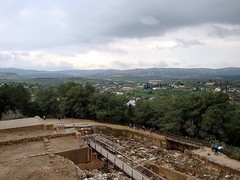
Historical Jesus scholars cannot deny the archaeological and literary evidence testifying to the grand economic importance of the major city of Sepphoris which was a mere one hour’s walk away from the “nobody-ever-heard-of-it” village of Nazareth. Why does such a major metropolis not once appear in the Gospels? Here is E. P. Sanders‘ answer:
Jesus was not an urbanite. The cities of Galilee — Sepphoris, Tiberias and Scythopolis (Hebrew, Beth-Shean) — do not figure in the accounts of his activities. He doubtless knew Sepphoris, which was only a few miles from Nazareth, but he nevertheless seems to have regarded his mission as being best directed to the Jews in the villages and small towns of Galilee. Nazareth was quite a small village. It was in the hill country, away from the Sea of Galilee, but Jesus taught principally in the villages and towns on the sea. . . . . (p. 12. The Historical Figure of Jesus)
Okay, that’s fine. But it also raises a question. Why do the Gospels so consistently speak of Jesus attracting a massively large following from far and wide — Tyre and Sidon and places beyond the Jordan and “Edom”, for heaven’s sake, many days’ walk from Nazareth — yet fail to mention Sepphoris. Why is Capernaum cursed as if it were a great metropolis whose inhabitants had rejected him, but nary a word of Sepphoris?

No. To fob this off by rationalizing that Jesus was “not an urbanite” is nonsense. The clear implication of the Gospels is that Jesus did at times venture into urban areas more sizable than Nazareth. We have to accept reports that indicate Jesus was interested in reaching out to people. In Mark 1 and 2 we read that Jesus did enter Capernaum, clearly a larger urban centre than Nazareth, on the shore of the Galilee lake. Yet even quite apart from the question of where Jesus went to deliver his message to save as many souls as he could, we are still left with the Gospel narrators’ perception that when hundreds and thousands flocked to see Jesus, they came from places we know as Lebanon, Syria and Jordan, as well as from sizable urban areas around the Galilee lake, the major city rubbing shoulders with Jesus’ supposed birthplace, Nazareth so famous that it attached itself as an epithet to Jesus’ name (Jesus of Nazareth), — yet not a single whisper of Sepphoris!
Note what we are told about Jesus and the big cities. Jesus frequented Capernaum and later described that place as having witnessed his works and being such a centre as to be “exalted unto heaven”:

Matthew 11:23
[23] And thou, Capernaum, which art exalted unto heaven, shalt be brought down to hell: for if the mighty works, which have been done in thee, had been done in Sodom, it would have remained until this day.
If Sepphoris were a major metropolis not far around that last bend in the road, then it surely sounds ridiculous to signify fishing village Capernaum — the scene of many of Jesus’ miracles and teachings — as an urban area “exalted to the heavens”.
When the author of the Gospel of Mark wanted to convey the wide extent of Jesus’ influence he mentioned major urban dwelling after urban dwelling but always happened to miss the one historical major urban dwelling but an hour’s walk from Jesus’ home-town:
Matthew 11:21-22
[21] Woe unto thee, Chorazin! woe unto thee, Bethsaida! for if the mighty wo
rks, which were done in you, had been done in Tyre and Sidon, they would have repented long ago in sackcloth and ashes.
[22] But I say unto you, It shall be more tolerable for Tyre and Sidon at the day of judgment, than for you.
And in Mark 3 we have major urban centres from as far off as Idumea, Jordan, Tyre and Sidon and Jerusalem. But still no Sepphoris!
[7] But Jesus withdrew himself with his disciples to the sea: and a great multitude from Galilee followed him, and from Judaea,
[8] And from Jerusalem, and from Idumaea, and from beyond Jordan; and they about Tyre and Sidon, a great multitude, when they had heard what great things he did, came unto him.
[9] And he spake to his disciples, that a small ship should wait on him because of the multitude, lest they should throng him.
Conclusion?
His “biographers” knew nothing of Sepphoris.
The conclusion from that conclusion?
The literary heritage of Jesus bears no relationship to historical geographic reality.
The rest?
Up to you. This is just one of many possible beginnings.

If you enjoyed this post, please consider donating to Vridar. Thanks!

“Historical Jesus scholars cannot deny the archaeological and literary evidence testifying to the grand economic importance of the major city of Sepphoris which was a mere one hour’s walk away from the “nobody-ever-heard-of-it” village of Nazareth. Why does such a major metropolis not once appear in the Gospels? Here is E. P. Sanders‘ answer:”
“Mark”, following Paul, has tried to find his Jesus in The Jewish Bible. So places in The Jewish Bible are more likely to be the setting than places not there. As Chef Tel-Dan would say, “Very simple, very easy, very niice.”
Joseph
The towns mentioned match in order the very same towns that Titus battled and conquered on campaign against the Jews which ended in Masada. Its that simple.
SANDERS
Jesus was not an urbanite. The cities of Galilee — Sepphoris, Tiberias and Scythopolis (Hebrew, Beth-Shean) — do not figure in the accounts of his activities.
CARR
You seem to have forgotten how arguments from silence work.
If something is not mentioned in the Gospels, it counts as data about the mindset of Jesus. It is silent data that gives us some of our background knowledge of the Historical Jesus.
This is how a true scholar uses arguments from silence.
You won’t find Sanders claiming that everybody already knew about Jesus well-publicised missions to the big towns of Galilee as the reason why they are not mentioned in the Gospels.
That is how you deal with silences in the Epistles , not silences in the Gospels.
Although to be fair, I think James Crossley uses the idea that if something is not mentioned, it is because the author knew his readers knew all about it.
And Richard Bauckham claims that people are mentioned in Gospels if the audience knew all about them, and not mentioned if readers didn’t already know all about them.
If something is not mentioned in the Gospels, it is the task of a scholar to come up with at least one rationale for it not being mentioned.
Got it!
Sepphoris, Tiberias and Scythopolis are not mentioned because they had so many followers of Jesus that the Gospellers needed to remain silent about these cities because the people of those towns needed ‘protective anonymity.’
Hence the massive number of followers of Jesus , and the lack of mention of any towns that all those people could have come from. A paradox easily resolved once we realise that these people needed protective anonymity.
Can I have my doctorate in New Testament studies now please?
Archeologists are 1) not even sure there was a Nazareth. And 2) if so … was Jesus even from there?
One possibility: to be a) “A Nazarite” was a common phrase referring to a particular temporary ascetic regimen: not cutting the hair; not drinking and so forth, until a given special task was completed. Possibly many texts confused being a “Nazarite,” with being b) a “Nazarene”: with a person from a town called Nazareth.
Jesus himself in at least one part of the Bible c) takes a similar oath on one particular occasion; vowing not to drink wine it seems, until a given task (the kingdom?) was completed.
Jesus might have been a Nazarite in the last days of his life. Perhaps causing the later false idea that Jesus was from a town named “Nazareth.”
At least one famous mythographer – Max Muller – in spite of his own occasional errors (over-emphasizing “solar” myths), often made many very useful observations about the origins of myths. Specifically Muller said that many myths seem to be generated by homophonic and punning linkages in languages. Words that sound alike especially, create many misconceptions. And many strange tales. Or myths. In this case, following Muller, we might suggest that a confusion about Jesus the “Nazarite,” misunderstood to be a “Nararene,” might have created the whole idea of Jesus having lived in this tiny (even then-nonexistent?) town.
Very interesting post. I think it would make a nice YouTube video segment.
From the E. P. Sanders quote above:
“He [Jesus] doubtless knew ….”
Note the ‘doubtless’.
Conclusion [JC exists] reached without justification so that that which follows is attempted rationalisation following the assumed conclusion.
Historically valueless.
No marks [thats a pun] for methodological validity.
The locations of the New Testament are symbolic rather than geographical. The symbolism of Jesus included the core idea “the last shall be first”. As a result, it made sense to locate Jesus in the invented town of Nazareth, a place that did not actually exist, something so “last” that no one had heard of it because no one lived there.
But then, when we discover that the person that everyone thought was greatest of all, “first” in the world – Jesus – is really from noplace, and is no one? Then the “first” becomes … “last.”
Maybe Jesus is symbolic as well. Perhaps the entire narrative is made up. Once one starts to introduce elements of creative narration, the story quickly begins to lose historical credability and becomes story telling.
“He [Jesus] doubtless knew Sepphoris, which was only a few miles from Nazareth, but he nevertheless seems to have regarded his mission as being best directed to the Jews in the villages and small towns of Galilee.”
“The Jews” are in the story purely to serve a literary and theological function, to ignore, ridicule, and ultimately execute Jesus so that the Greeks can justify to their converts the wholesale theft of Judaism. It’s utterly fatuous to posit that an historic Jesus regarded his “mission” as being “best directed to the Jews.”
all of this reminds me of Bern Jörg Diebner, a provo from Heidelberg and his article in Dilheimer Blätter: Es lässt sich nicht beweisen, Tatsache aber ist. Sprachfigur statt Methode in der alttestamentlicen Forschung (You cannot prove it, but it is a fact. Figure of speech instead of method in OT studies). Just as good in NT studies.